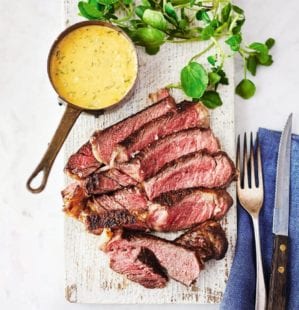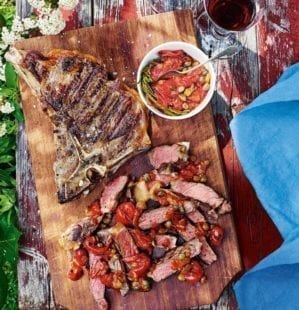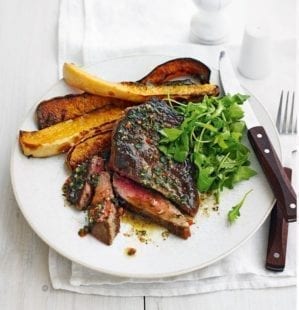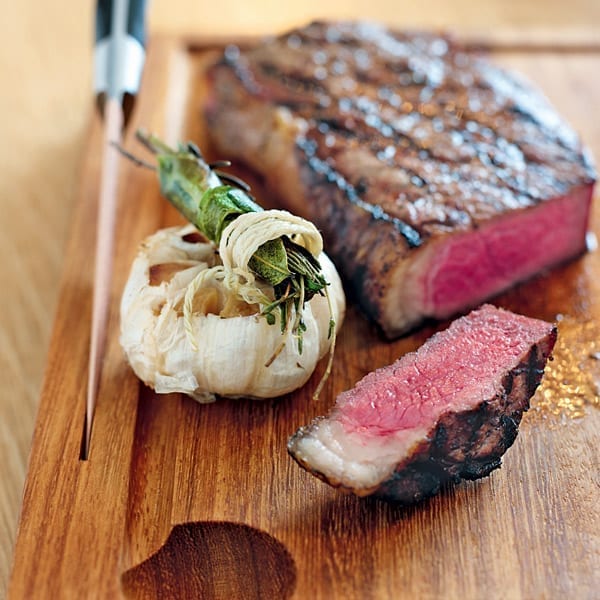How to shop for steak and the best cuts to buy
Good steak isn’t cheap – nor should it be. Don’t be afraid to quiz your butcher about where it comes from – and follow our buying advice. We’ve also got a great guide on the different cuts of steak and tips on how to cook them.
Once you’ve got your steak, here are some steak recipes for you to use them in.
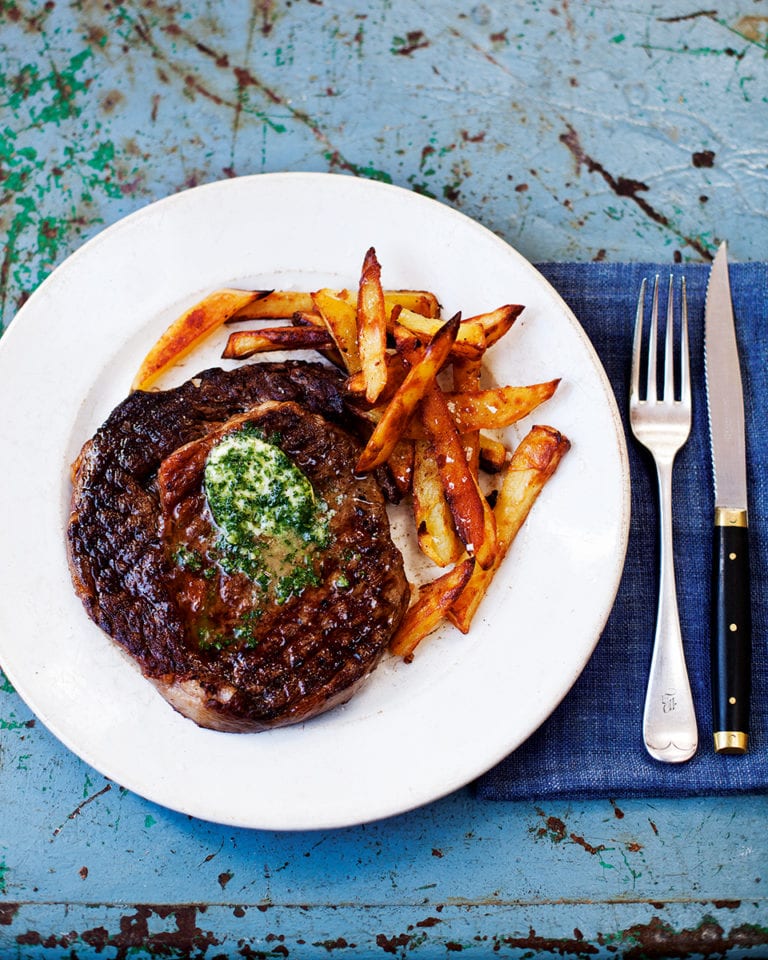
Shopping for steak
- For a flavourful steak, go for meat from an animal aged 24 months or older. Contrary to popular belief, older animals don’t necessarily produce tougher steak.
- Look for marbling (flecks and veins of fat). Although it doesn’t guarantee flavour, a good steak should have a bit of it. Why? Because the fat melts during cooking, keeping the meat moist. It’s the flesh itself, not the marbling, that gives that intense beefiness, so don’t fret if a steak with an otherwise good pedigree has little marbling.
- Ask for meat from cattle that have been grass-fed (the fat may have a yellowish tinge to it). The US champions its grain-fed beasts and touts their superior fat marbling, but in fact a cow’s digestive system isn’t designed to eat corn. Plus, meat lovers will tell you grass-fed beef has a superior flavour.
- Look for dry-aged beef that’s been aged for at least 21 days (28 or more is best). When beef joints are aged (hung in climate-controlled conditions) they lose water and their fibres begin to break down, increasing the tenderness of the meat and intensifying the flavour. Wet ageing (where the meat is left in vac-pacs) breaks down the fibres too, but not as much as dry ageing.
- Buy British. It’s up to you of course, but we don’t think you can beat British. Why ship something frozen from Argentina or the US when our cattle are some of the best in the world, our grass quality is second to none and we have higher welfare standards than many countries? Plus, our farmers need all the help they can get.
Five different cuts of steak
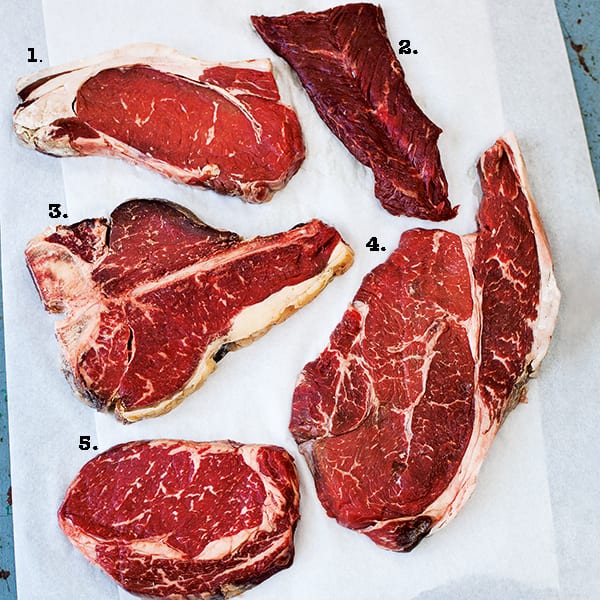
- Sirloin
It’s from the back of the ribs, above the fillet, and its tenderness is second only to fillet. The fatty edge bastes it beautifully so don’t trim, but pick up the steak with tongs after cooking and sear the fat more, if you like. - Onglet
Also known as hanger or skirt is the long, thin diaphragm muscle. With open fibres and a dark colour, it’s very lean and flavourful but needs to be cooked rare to keep it tender. It’s also excellent value and the cut that foodies are raving over. - T-bone
This is the sirloin and fillet in one, with a spinal bone through the centre giving lots of flavour as it cooks. The fillet cooks faster than the sirloin, so use a fish slice to press down the sirloin on the griddle during cooking. - Rump
Cut from the top of the hindquarters. Not too pricey and, because it’s a hardworking muscle, it’s full of flavour. Rump can be a bit tougher than other steaks and is traditionally cut a little thinner. - Rib-eye
Taken from the fore-rib with the bone and some outer meat removed. It has a ribbon of fat through the centre and rib-eye lovers reckon this cut offers the perfect combination of flavour and tenderness.
How to cook the perfect steak
- Bring the meat up to room temperature before you begin so it cooks more evenly throughout.
- The best way to cook a steak is on a griddle pan. Let the pan get smoking-hot before you cook.
- Oil the steaks with sunflower or groundnut oil and season well with sea salt and black pepper just before you cook them. When cooking anything at a high temperature it’s best to oil the food rather than the pan. That way you use less oil, minimise smoke and reduce any burnt-oil flavour tainting your food.
- After cooking, allow the steak to rest, uncovered, for 2-3 minutes. Stir any juices into sauces.
- The cooking times below are for steaks 2-2.5cm thick (apart from the onglet which comes as it’s butchered). We reckon this is an optimum thickness but if yours is thicker, pop in a preheated 200°C/fan 180°C/gas 6 oven for a few minutes after griddling.
Cooking times for steak
- Sirloin: Best medium rare, 2 minutes each side.
- Onglet: Best cooked rare to keep it tender – no more than 1½-2 minutes each side.
- T-bone: Best medium rare, 2 minutes each side; add an extra 30 seconds each side for medium.
- Rib-eye: Best medium rare, 2 minutes each side.
- Rump: Best medium, 2 minutes on each side.
Wine to go with steak
Steak is overwhelmed by rich red wines so choose medium-bodied, juicy reds. Best of all are Tuscany’s finest. So go for Chianti Classico or Brunello di Montalcino.
Subscribe to our magazine
Food stories, skills and tested recipes, straight to your door... Enjoy 5 issues for just £5 with our special introductory offer.
Subscribe
Unleash your inner chef
Looking for inspiration? Receive the latest recipes with our newsletter
